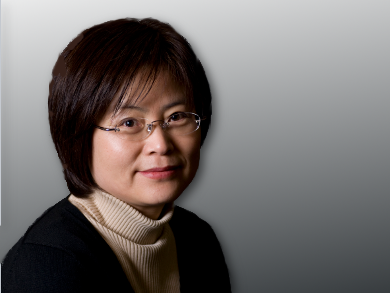Dr. David Peralta, Editor-in-Chief of ChemMedChem, talked to Professor Hyun-Soon (Joy) Chong of Illinois Institute of Technology, Chicago, USA, about her recent article Theranostic Polyaminocarboxylate-Cyanine-Transferrin Conjugate for Anticancer Therapy and Near-Infrared Optical Imaging. The article was also featured on the journal’s front cover as you can see below.
This article deals with theranostics and antibody-targeted therapy. Could you please explain these terms?
Theranostics consists of therapeutic and diagnostic components. The single agent is designed for simultaneous treatment and imaging and post-treatment monitoring of various diseases including cancers.
The antibody here is a tumor-seeking biomolecule with high binding affinity for an antigen present on tumors. In antibody-targeted therapy, an antibody is used for selective delivery of toxic chemo- or radiation drugs only to tumor cells, while saving healthy cells and minimizing toxic side effects during the cancer therapy.
Could you briefly explain the key findings of your study to a non-specialist and why it is of current interest?
Iron is a biologically important metal that is involved in initiation and progression of cancers. Rapidly dividing cancer cells require more iron than normal healthy cells and are sensitive to depletion of cellular iron. Iron depletion has been explored as a cancer therapeutic strategy.
Many small molecules have been prepared and evaluated as potential iron-depleting antitumor agents. In this paper, we reported the first example of multifunctional drugs containing a potential iron-depletion drug, antibody, and dye that can target tumors and simultaneously destroy and visualize them.
What was the inspiration behind this study? What made you pursue this specifically?
I am a trained organic synthetic chemist and have worked on design and synthesis of small molecules to sequester biologically important metals with therapeutic and diagnostic applications. My continued research towards development of effective metal-sequestering agents led to potential iron-binding small molecules that display inhibitory activities against various cancer cells. However, a small molecule drug typically has a short plasma residence time, rapid renal clearance, and off-target toxicity profile. I was interested in the design of tumor-specific theranostic agents built on the cytotoxic metal-sequestering agents.
Which part of your work proved most challenging?
Building a multifunctional system while controlling interrelated therapeutic and imaging parameters was a challenging task. Completion of the animal studies required selecting the specific cancer cell line that is sensitive to iron or metal depletion and also has an elevated expression of the antigen that can interact with the antibody.

How will you follow up on this discovery?
I plan to conduct comparative animal studies to evaluate promising theranostic conjugates for systematic therapeutic efficacy, toxicity, and imaging sensitivity and in-depth studies for understanding the cytotoxic mechanism of the chelating agent and its analogues.
Are there any other topics that your lab is currently interested in?
My research involves organic synthesis, medicinal chemistry, synthetic methodology development, and bioconjugate chemistry. I lead an interdisciplinary research group working on the development of molecularly targeted drugs for treatment and imaging of cancer, including small-molecule inhibitors and nuclear medicine. Particularly, my lab specializes in synthesis and biological evaluation of chelating agents for radionuclides used in therapeutic, diagnostic, and theranostic nuclear medicine with biomedical and radiopharmaceutical applications, including radioimmunotherapy and positron emission tomography (PET) imaging.
The article they talked about
- Theranostic Polyaminocarboxylate-Cyanine-Transferrin Conjugate for Anticancer Therapy and Near-Infrared Optical Imaging,
Siyuan Ren, Xiang Sun, Haixing Wang, Trung Hai Nguyen, Negar Sadeghipour, Xiaochun Xu, Chi Soo Kang, Yujie Liu, Hua Xu, Ningjie Wu, Yanda Chen, Kenneth Tichauer, David D. L. Minh, Hyun‐Soon Chong,
ChemMedChem 2018.
https://doi.org/10.1002/cmdc.201800598





